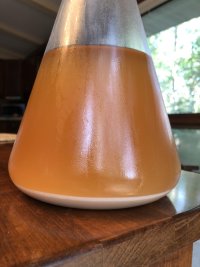That looks decent for a swirled starter. The thin white layer is the best, most pure yeast; the darker layer underneath is a mixture of that same pure yeast as well as dead cells and trub. At this point, all of it is useful.
After crashing a little longer and decanting, I'd make another starter with the leftover slurry. Then you'll have enough for a good solid 5 gallon Lager pitch and save some (20-30%) out for the next starter.
If you brew often enough look into a stir plate. You could even build one, and while at it, build 2, or a twin setup.
BTW, I just cooked up another batch of 4 gallons concentrated (1.092) starter wort. I'm freezing most of it in 48 oz tubs. At time of use they get diluted 1.5x for 1.037 starter wort. Reboiled for all security.









































![Craft A Brew - Safale S-04 Dry Yeast - Fermentis - English Ale Dry Yeast - For English and American Ales and Hard Apple Ciders - Ingredients for Home Brewing - Beer Making Supplies - [1 Pack]](https://m.media-amazon.com/images/I/41fVGNh6JfL._SL500_.jpg)


















